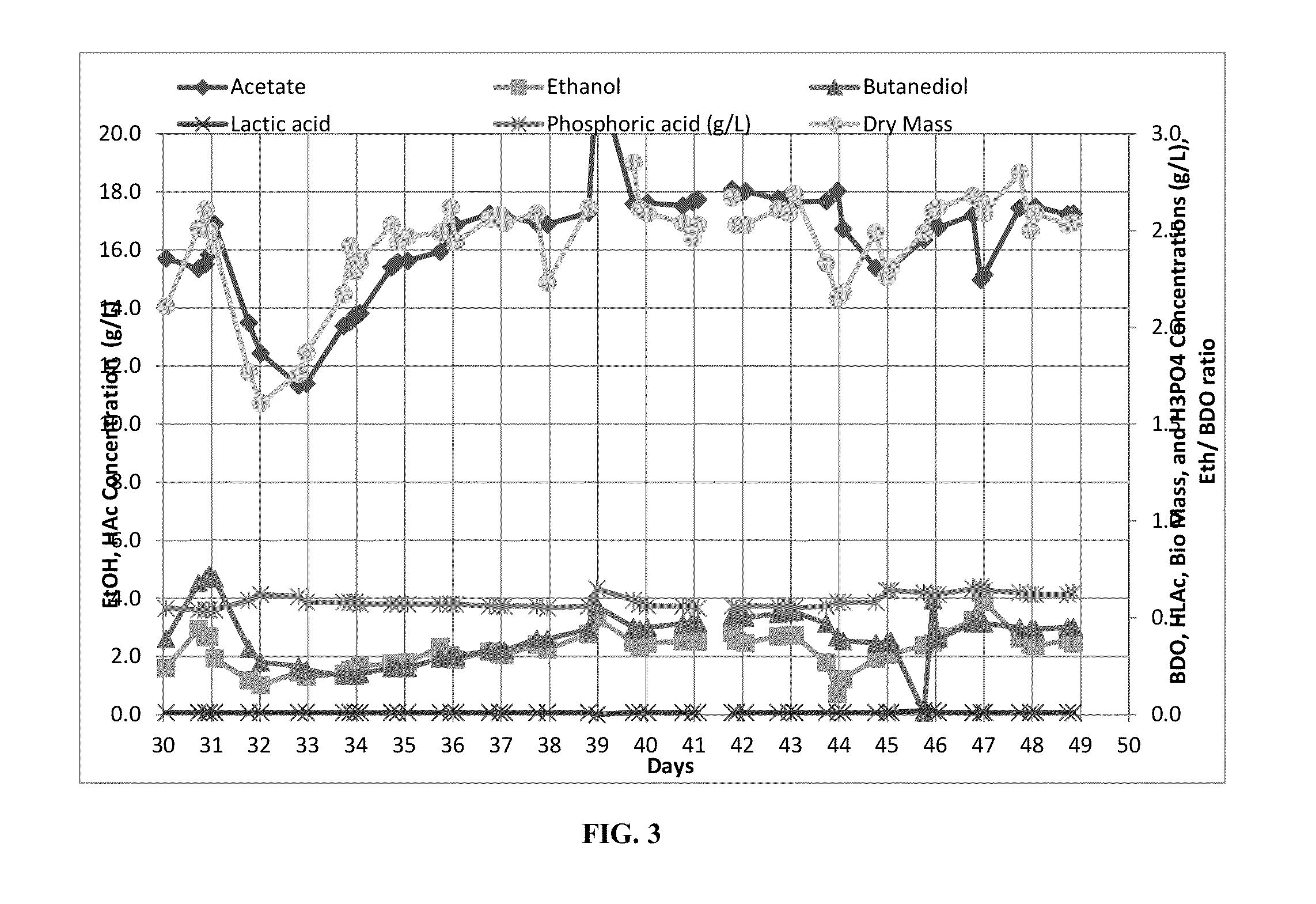Fermentation process for the production of lipids
a fermentation process and lipid technology, applied in the field of lipid production, can solve the problems of inability to meet the economic sustainability of starch or sucrose-producing crops for ethanol production in all geographies, the difficulty of generating feedstocks, and the difficulty of ensuring the economic viability of the crop, so as to achieve the effect of increasing the production of lipids in the secondary bioreactor
- Summary
- Abstract
- Description
- Claims
- Application Information
AI Technical Summary
Benefits of technology
Problems solved by technology
Method used
Image
Examples
example 1
Fermentation of CO in Bioreactor to Produce Acetate
[0156]A glycerol stock of a Clostridium autoethanogenum was revived in serum bottles. The glycerol stock stored at 80° C. was slowly thawed and transferred into the serum bottle using a syringe. This process was carried out inside an anaerobic chamber. The inoculated serum bottle was subsequently removed from the anaerobic chamber and pressurized to a total of 45 psi using a CO-containing gas mixture (40% CO, 3% H2, 21% CO2, 36% N2). The bottle was then placed horizontally on a shaker inside an incubator at a temperature of 37 C. After two days of incubation and after verifying that the culture grew, the bottle was used to inoculate another set of eight gas containing serum bottles with 5˜mL of this culture. These serum bottles were incubated for another day as described above and then used to inoculate 5 L of liquid medium that was prepared in a 10 L CSTR. The initial CO containing gas flow was set at 100˜mL / min and the stirring ra...
example 2
Fermentation of CO2 and H2 in Bioreactor to Produce Acetate
[0158]Media at pH 6.5 was prepared as using the protocol defined by Balch et al (See, e.g., Balch et al, (1977) International Journal of Systemic Bacteriology., 27:355-361). A three-litre reactor was filled with 1500 ml of the media. Oxygen was removed from the media by continuously sparging with N2. The gas was switched from N2 to a mixture of 60% H2, 20% CO2, and 20% N2 30 minutes before inoculation. The inoculum (150 ml) came from a continuous Acetobacterium woodii culture fed with the same gas mixture. The bioreactor was maintained at 30° C. and stirred at 200 rpm at the time of inoculation. During the following batch growth phase, agitation was increased incrementally to 600 rpm. The gas flow was increased incrementally by 50 ml / min according to the dropping H2 / CO2 in the headspace as a result of the increasing biomass. To compensate for the acetic acid produced, the pH was automatically controlled to 7 using 5 M NaOH. ...
example 3
Microalgae Acetate Utilisation
[0161]It has recently been demonstrated that the microalgae may utilise acetate as a carbon source for production of lipids. Ren et al. have shown that Scenedesmus sp. cultured in a liquid medium comprising acetate as a carbon source produced a total lipid content 43.4% and a maximum biomass concentration of 1.86 g L−1 (Ren, H., Liu, B., Ma, C., Zhao, L., Ren, N. “A new lipid-rich microalga Scenedesmus sp. strain R-16 isolated using Nile red staining: effects carbon and nitrogen sources and initial pH on the biomass and lipid production. Biotechnology for Biofuels, 2013, 6(143)).
[0162]In the present system, acetate derived from anaerobic fermentation of a gaseous substrate is fed to a CSTR comprising microalgae, such as Scenedesmus sp. The microalgae is cultured in media at 25° c. and a pH of 7. Agitation is set at 150 rpm. A nitrogen source, such as sodium nitrate, should also be present in the media at a range between 0.1-1.0 g / L, depending on the ace...
PUM
| Property | Measurement | Unit |
|---|---|---|
| temperatures | aaaaa | aaaaa |
| pH | aaaaa | aaaaa |
| pH | aaaaa | aaaaa |
Abstract
Description
Claims
Application Information
 Login to View More
Login to View More - R&D
- Intellectual Property
- Life Sciences
- Materials
- Tech Scout
- Unparalleled Data Quality
- Higher Quality Content
- 60% Fewer Hallucinations
Browse by: Latest US Patents, China's latest patents, Technical Efficacy Thesaurus, Application Domain, Technology Topic, Popular Technical Reports.
© 2025 PatSnap. All rights reserved.Legal|Privacy policy|Modern Slavery Act Transparency Statement|Sitemap|About US| Contact US: help@patsnap.com


